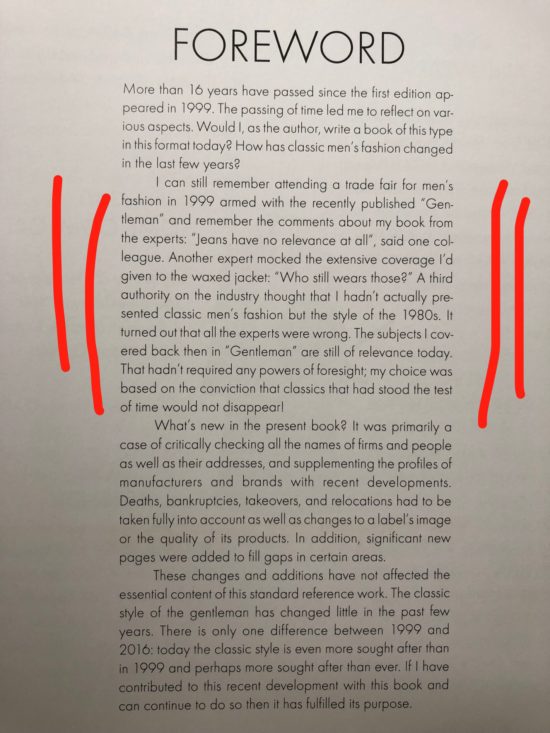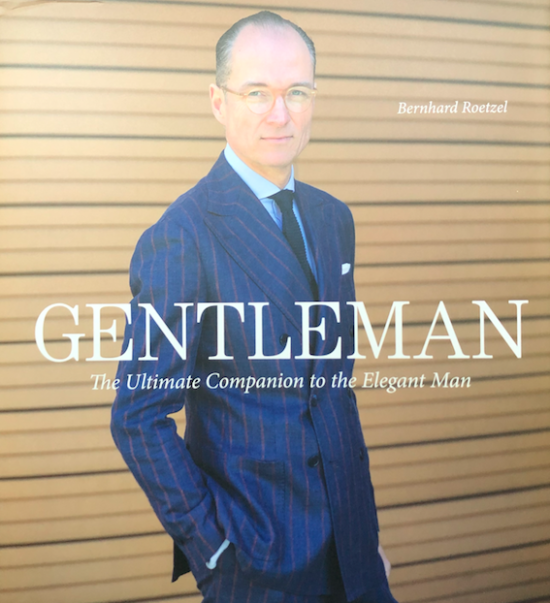The Bernhard Roetzel Gentleman: The Ultimate Companion to the Elegant Man 2018 Edition is now out. The original came out in 1999 and has been a favorite of men interested in classical style ever since.  Read this interview to gain an understanding of his ideas in greater depth.
The publication of Bernhard Roetzel’s book prompted a spirited discussion in my wechat group, Tweed and Ties, that included such colorful commentary as this:
“He sounds like he has a very small and tight bung hole. Forward encouraged me to steer clear of this catalogue. Thank god he does not mention the effect of social media on fashion or sports lifestyle.â€
Click more to read the forward.

“I guess it depends on how you define classic,” said someone else. Well,Bernhard Roetzel does define classic menswear. That’s the goal of his book. Of course there is something annoyingly smug about the forward. As Anatole Pang (blog here) comments, it’s almost a tautology that classic will be enduring:
“It’s like predicting that the tide will come in. ‘Mark my words, it will; and if it does, remember that it was I who predicted it!'”
Bernhard Roetzel does looks smart in the photo above. There is something so irredeemably square about the images in the original 1999 Gentleman: The Ultimate Companion to the Elegant Man book that you would think square is going out of style. But the whole point is that it’s not. It’s back, time after time.
Of course everything he says is right. There are not multiple definitions of classic. It’s hard to argue with the classics Roetzel puts in Gentleman. Most people could use a Barbour. Classic menswear has also enjoyed a major resurgence recently. The tide has come in again.
And yet, the tide did not lift all boats. The attire of most men used to somewhat resemble at least some version of classic menswear. Now it’s all about tribes or just being totally slovenly. Classic menswear has become one of many “looks” from which to choose. It is now more exclusive and harder to attain.
When Roetzel wrote the first edition, classic style was just the way men dressed. Now it’s more of a style choice, which makes it much less democratic. You either have to do the “total look” perfectly – shopping at Mark Cho’s The Armoury and going full bespoke or just be frumpy. In 1980, a guy could probably have worn a decent tweed jacket with a slightly too roomy fit, wool trousers with too much or too little break, and any silk tie and still be considered well dressed enough, or at least decent and respectful. Now, the same look might be considered professorial and out of date or, in China, one might look like a real estate agent without a perfect suit.
After business casual, hoodies, tech, athleisure, that sort of louche Gucci-type man of high fashion, and various bohemian and hipster trends, classic menswear is one of many ‘looks’ and more of a deliberate identity choice than just how men normally dress. It may well be the most enduring, refined, expensive, high quality, etc. of the many styles on offer – and it probably is the most difficult one to achieve in terms of effort and financial commitment. Â
I’m also curious about how Roetzel treats the question of silhouette. He must denounce slim-fixation in the book, though I wouldn’t be surprised if he has embraced at least a somewhat sharper fit over the last two decades. The slimmer silhouette also exclusiveness of classic style, since you need to be in good shape.
The end of an attainable norm when it comes to classic menswear might also reflect the demise of the middle class after their rather short heyday from 1950s-80s. There was a democratization of classic style that occurred in that period. Now people must either be perfectly fitted and razor sharp in classic menswear, embrace a niche style tribe or, most likely, they simply dress in nondescript casual clothes. Bernhard Roetzel’s Gentleman: The Ultimate Companion to the Elegant Man will still have many admirers among diehard devotees of classic style that get every inch of their outfit perfect, but the mass of reasonably well-dressed guys who wore department stores suits and an alright navy blazer are less and less common.

